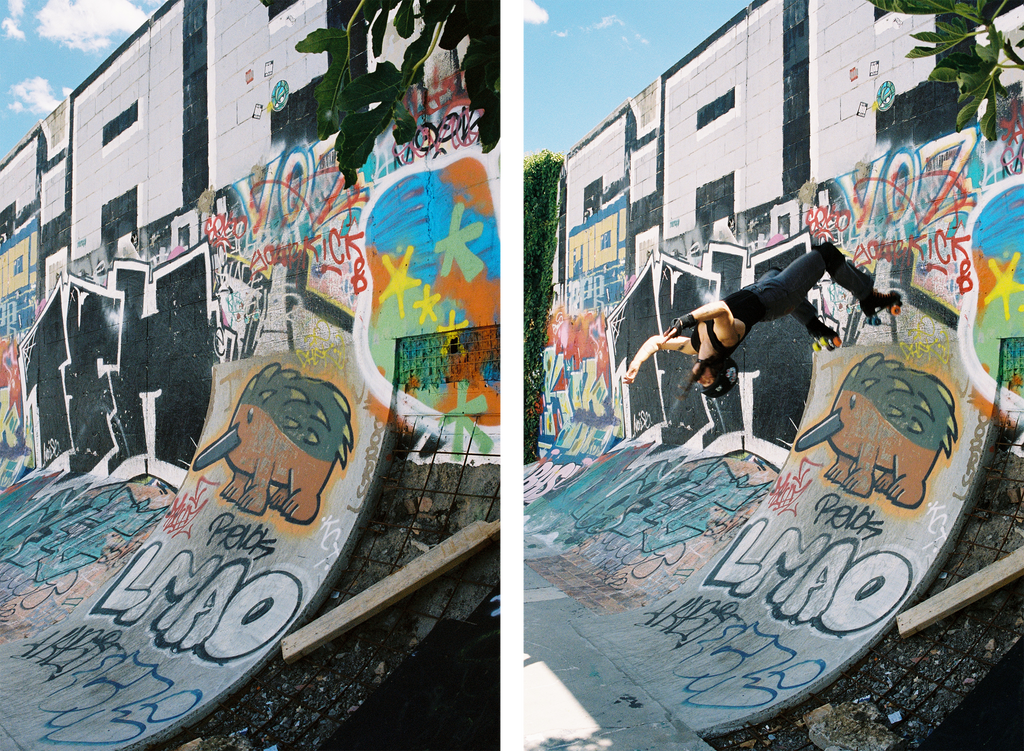Written by Samantha Trayhurn.
You know it. I know it. Heck, even the scooter kid at the skatepark knows it. Seeing someone perform a flip on skates is a damn impressive physical feat. However, with great excitement comes a greater degree of stress on your poor ol' skate gear. Here, we will delve a little into how the impact generated during flips (and other high impact tricks, too) can potentially lead to broken roller skate parts.

.Image by Lauren Acland.
To flip or not to flip isn't the question. If you want to get upside down, you shouldn't let anyone hold you back. BUT, just remember it might mean more regular maintenance or updates to your skate kit.
-
The Physics of Flipping: When executing flips, skaters rely on their skill, strength, and body control to rotate their bodies in the air and land safely. While flipping, a significant amount of force is exerted on various parts of the skates. This force can be intense and often beyond what roller skates were originally designed to withstand.
-
Landing Impact: One of the critical moments during flipping is the landing. When skaters come back in contact with the ground after completing a flip, the force generated upon impact is substantial. This impact is transmitted through the skates and absorbed by their components. Over time, this repetitive stress can weaken or damage different parts of the skates, especially when impact is not distributed evenly due to form or technique.
-
Stress on Plates: Roller skate plates provide the structure and support necessary for stability and manoeuvrability. During flips, the plates are subjected to considerable stress. The sudden impact upon landing can cause bending, warping, or even fracturing of the plate. Weaker or lower-quality plates are particularly susceptible to damage under these circumstances. Most stock roller skate plates are not designed with flips in mind, and you may want to consider upgrading your gear to something very heavy duty.
-
Impact on Trucks: Trucks are the metal components that connect the wheels to the skate's plate. They enable turns and pivots, allowing skaters to manoeuvre with ease. However, the force generated during flipping can put excessive stress on the trucks, leading to bent axles. This damage can impair the skater's ability to control their movements effectively. In some extreme circumstances when weight is disproportionately sent through one axle, they could snap.
-
Boot Integrity: The boot is the primary component that provides support and protection to the skater's foot. Flipping can subject the boot to immense stress, potentially causing cracks or fractures in the material. This compromises the overall integrity of the boot, reducing its ability to provide adequate support and increasing the risk of injury.
If you are consistently breaking gear, it might be time to:
- Consider whether your technique is contributing to breakage through uneven weight distribution, sloppy landings or other matters of form. You could try working on these skills off-skates to lessen the amount of cost and risk involved.
- Consider an upgrade. Often through research and testing, skaters find what works for them. If you keep breaking the same piece of gear, it might not be what's right for you.
So, while flipping on skates can be flippin' cool, it's important to recognise the toll it takes on your gear. Sometimes to keep gear affordable, it can't always be made with flips in mind, as this isn't what the majority of skaters are doing. If you ARE doing flips though, it means you are pretty special. Just remember to regularly check and maintain your skates, and don't be too bummed out if breakages occur. Most high level athletes go through more gear than the standard user, and it comes with the territory of pushing your limits.

Image by Sugu Valbuena
